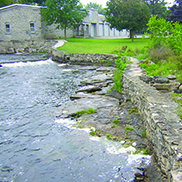Full Catchment Report

Middle Rideau Subwatershed Report 2015
RIDEAU-SMITHS FALLS CATCHMENT
The RVCA produces individual reports for ten catchments about environmental conditions in the Middle Rideau subwatershed using data collected and analysed by the RVCA through its watershed monitoring and land cover classification programs every six years.
This information is used to better understand the effects of human activity on our water resources, allows us to better track environmental change over time and helps focus watershed management actions where they are needed the most to help sustain the ecosystem services (cultural, aesthetic and recreational values; provisioning of food, fuel and clean water; regulation of erosion/natural hazard protection and water purification; supporting nutrient/water cycling and habitat provision) provided by the catchment’s lands and forests and waters (Millennium Ecosystem Assessment 2005).
The following pages of this report are a compilation of that work and contain information on surface water quality, riparian conditions, land cover, stewardship activity and hazard land and water resources protection.
The Town of Smiths Falls has recently completed a number of Master Planning initiatives (as part of its Official Plan review process) including: the Downtown Revitalization and Waterfront Integration Master Plan (2013), the Downtown Community Improvement Plan (2013), the Smiths Falls Cultural Master Plan (2013) as well as the priorities of the 2011-2013 “Turning Point” Economic Development Action Plan, culminating in the release of the Smiths Falls 2034 Official Plan (2014).
The following list of “Challenges/Issues” and “Opportunities/Actions” contains some of those items (identified with an asterisk) taken from the Official Plan (with input from staff) and Master Planning documents that have implications for the sustainable use and management of the water resources of the Rideau River and Canal and lands adjacent to the waterfront in the Town of Smtihs Falls.
Surface water quality data is unavailable for the Rideau River and Canal flowing through the Town of Smith Falls and the catchment at large
Town of Smiths Falls
Townships of Drummond/North Elmsley and Montague
Town of Smiths Falls
Rideau-Smiths Falls Catchment